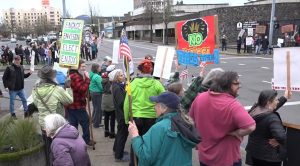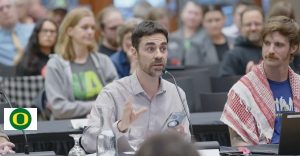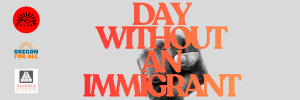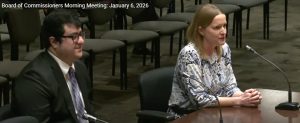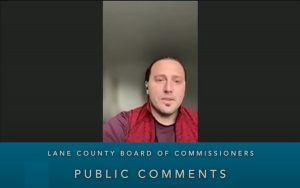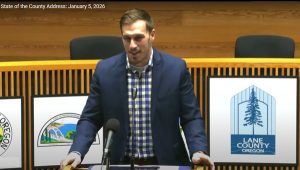Mayor-elect hopes to bring sustainable urban design to downtown Eugene
7 min read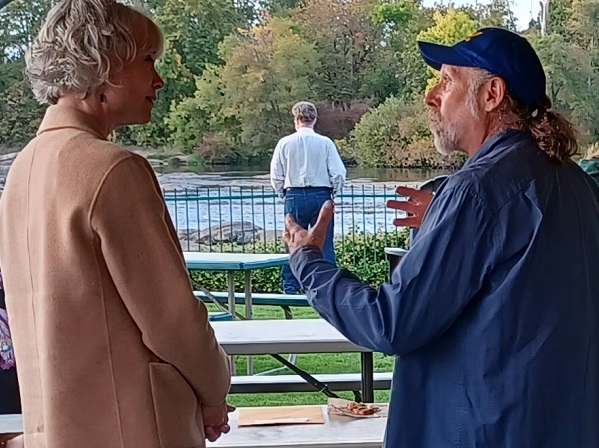
Eugene’s Mayor-elect Kaarin Knudson is excited about bringing sustainable urban design to the city’s future.
Eugene Mayor-elect Kaarin Knudson: My name is Kaarin Knudson, and it truly is my distinct honor and privilege to be the future mayor of Eugene. I am an architect, a licensed architect in the state of Oregon who is trained as a journalist, so I come from a particular orientation to stories and to the narrative of places and understanding the character and the nature of community.
[00:00:27] I came back to Eugene in 2004 for a master’s degree, chose to come back to Oregon because I wanted to be a place-based professional. I wanted to be an architect who was investing in the landscape that I was practicing within.
[00:00:42] So 20 years of practice within architecture, focused on sustainable design, a wide variety of projects: mixed-use redevelopment, small pocket neighborhoods, senior centers, community centers, inclusive neighborhood design, tricky renovations, a really loving restoration renovation project in the Hult Center that remains one of my favorite projects, because that building is such a diva.
[00:01:09] But also in 2009 to 2011 on the master planning and public involvement process for what was then the EWEB riverfront property, now the downtown riverfront, and it’s a really tremendous opportunity for us as a community to reinhabit a space and also bring ecological functions and social engagement back to an area that hasn’t had that happening in that way for a very long time.
[00:01:35] The other piece of work that I wanted to do, when I decided to hang my own shingle and create my own small firm about ten years ago, was public interest work and the ways in which we as a community lead ourselves into the future, right?
[00:01:51] That’s grown into the independent nonprofit 501(c)(3) Better Housing Together. We have a partner network, about 50 organizations and businesses with a huge diversity of interest and expertise.
[00:02:04] When we organized that work, it was with a vision and a framework that is often described as a collective impact model. Collective impact observes that when we’re trying to address a structural, systemic challenge, one perspective is never going to be enough, no matter how much energy and resources behind that one perspective. We actually need the full spectrum of expertise within communities, organized together, working together in order to make progress.
[00:02:31] John Q: The mayor-elect, Chamber of Commerce, realtors, and other leaders have been promoting a framework for addressing homelessness.
[00:02:40] Kaarin Knudson: We are right now working on organizing a community event that will be on Nov. 21 at the University of Oregon, and this event will be a free public lecture. We’ll get word out. But it will be a ‘Housing Solutions Summit,’ and we’ll be bringing Gregg Colburn from the University of Washington to Eugene to talk about his book, ‘Homelessness is a Housing Problem.’
[00:03:03] The reason that we are bringing Gregg Colburn to Eugene for this conversation is that he has looked at cities all across our country. And when you have a high incidence level of homelessness, like what exists in Eugene, it’s really driven out of two variables, two data points. One of them is the unaffordability of an average unit of housing, average apartment relative to income, so basically that housing is unaffordable to most people. And then a very low vacancy, those two things together.
[00:03:34] It’s not the incidence of serious mental illness, or how generous the community is, or how progressive or conservative the community is, or the degree of poverty… it’s really those two variables: unaffordable housing and not nearly enough vacancy. It’s a brutal game of musical chairs. And always the people who are most vulnerable or have the least resources are going to lose out.
[00:03:57] John Q: She said besides single-family homes, the city needs more variety in its housing.
[00:04:02] Kaarin Knudson: As you all know from visiting other places in the world and other cities, you’ve probably walked through a lot of really delightful neighborhoods with brownstones and triple-deckers and cottage clusters and courtyard housing, right? These are all typical American residential homes, very typical, and exist in an abundance in other places.
[00:04:22] But they don’t exist here, because we didn’t grow up as a community when that was the predominant type of development, the common pattern and the predominant housing type that was being built.
[00:04:32] We don’t have a lot of places now where you can go from a residential unit that’s living above the store, so to speak (which is another great book and a fantastic pattern that persists all around the world—it’s how Jane Jacobs became an extraordinary American urbanist. She was living above the store and looking out her window to the street below and observing the life that was present there). That pattern is not the predominant pattern that we have to work with, but it is a pattern that we can stitch back into our communities over time, very incrementally.
[00:05:04] This process—Ted (Coopman, Jefferson Westside Neighbors) and I were talking about before the meeting—takes a long time. The built environment takes a long time to change across the areas that we’re occupying and are within our urban growth boundary.
[00:05:16] But when we’re thinking about our larger housing needs in the community, we also really need to be thinking about our downtown and focusing energy and attention on the creation of new residential places and units within our town center.
[00:05:33] We don’t have people living in our city center, not nearly enough of them living there in their home and walking downstairs to a small business, being at that corner cafe, being a regular patron to that restaurant that’s just down the block. And that is one of the reasons why our downtown continues to struggle, is that we just don’t have the population within our city center to support active and vibrant spaces.
[00:06:01] We want to locate high-density housing in places where people have walkable access to things that they need, where we can have access to good transportation options and safe transportation options. That starts to work together to create a pattern of community and development that’s really positive.
[00:06:19] John Q: One participant said she experienced a carjacking attempt downtown.
[00:06:26] Kaarin Knudson: I do think that we face a really significant challenge in downtown, and that’s why the city also has to be involved, because we are now in a sort of chicken or an egg circumstance wanting for new investment to come into that environment. And that’s a really difficult circumstance to bring new investment into, when there is an environment that may not be perceived as feeling safe.
[00:06:48] The public space is operating as a proxy for services that are not provided. And that is a really difficult thing for public space to do because it’s not designed to do that. It was never intended to be utilized in some of the ways that spaces are being utilized.
[00:07:04] But as you bring a reinvestment into an area, a new life, literally new lives of people into an area, that place changes. And there are behaviors that happen in certain spaces when a public space is essentially understood to be vacant that would not happen if those spaces were occupied.
[00:07:23] John Q: She noted 70 acres of surface parking lots downtown.
[00:07:27] Kaarin Knudson: Those are absolutely spaces that are not contributing to the liveliness of downtown during non-business hours, even during business hours. They’re absolutely contributing to heat island effect in that neighborhood. And they are not participating ecologically, because most of these parking lots were built before any parking lot standards were in place. So there’s no trees, there’s no shade, there’s no stormwater management.
[00:07:48] Those are opportunity sites for us to be thinking about in our city center. Because as you imagine the experience of being a pedestrian in our city centers, you also know that there are huge expanses when there’s nothing activating the street edge that you’re walking along. There might not be any trees, which is, you know, truly a tragedy in that public space. But there also might not be anything along the interior edge. The private realm of that experience. It’s just open space or storage of vehicles.
[00:08:17] Parking is a need absolutely in the city center. But as we’re thinking about new generations of development and new habits and new opportunities people have for transportation options, that is going to be something that we have to improve on this next chapter of development. We won’t do the same thing that we did in the mid-century again.
[00:08:38] John Q: Ted Coopman from Jefferson Westside encouraged the city to invest in adjacent neighborhoods.
[00:08:44] Ted Coopman: Redevelopment downtown is super important. It’s important to the people in our neighborhood, because a lot of us live in that neighborhood so we can go to the Hult Center, so we can go downtown, so we can go to Farmers Union and have coffee and things like that.
[00:09:00] We’re thinking about downtown, as my mom would say, in a backasswards way. I think we need to look at downtown as the hole in the donut. And I think that if we put money into those adjacent neighborhoods that are around downtown, and do a lot to really revitalize them—this is a huge resource. It’s an underperforming asset and we have done a terrible job preserving our historic, architectural legacy. There’s nothing left downtown. It’s been bulldozed for parking.
[00:09:33] John Q: She wrote the book on sustainable urban design; now she’s looking at better uses for 70 acres of downtown parking lots. Kaarin Knudson speaks with Eugene Neighborhoods Inc. at their annual meeting Oct. 10. The next mayor of Eugene announces that Gregg Colburn, author of Homelessness Is a Housing Problem, will come to the University Nov. 21.
Image courtesy KEPW 97.3 Whole Community News: Kaarin Knudson and Ted Coopman discuss housing and urban development Oct. 10, 2024 before the annual meeting of Eugene Neighborhoods Inc. at Roaring Rapids Pizza Company in Glenwood.
